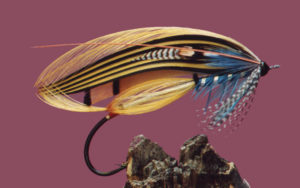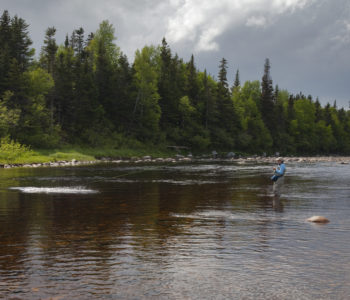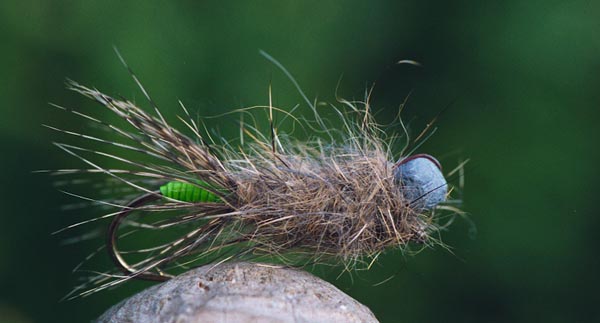
A few simple tricks to improve your catches with…
Fly fishing for Atlantic salmon with dry flies is a little different from trout fishing, but has several similarities with fly fishing for big grayling. I learned a lot of my fly fishing skills and experiences from grayling fishing, and many tricks that I used to catch grayling worked very well for Atlantic salmon also. To improve the number of catches, I don’t use or follow any rules, but instead I can give you some tips that might be very helpful when you have problems catching fish. Many of these tips I learned by experience, but also by very good observation. Learning and developing the fly fishing talents are very important for a fly fisher, and even very experienced fly fishermen can learn a lot from a beginner, even when they sometimes just show certain things that you never should do. I often use mistakes from my early days and from other people in my workshops and classes. One of the most common mistakes that people make with fly fishing for salmon is walking into the pool right away.
In Newfoundland the salmon sometimes can have their lies very close to the riverbank, so my first tip would be to very closely observe the pool that you want to fish. Explore the water with polarized glasses so you can see the rocks and holes a lot better, and perhaps even spot some salmon too. Try to think like a salmon and search for the easiest ways to travel upstream. What route would you take if you were the salmon, what rock you will pick to take a break behind after you just have passed some real turbulent water? They will try hard to find the ways that cause them less effort. While you gaze into the pool, also try to find and discover the places that are most welcome to them for a good lie; lies that give them both shelter and protection. Don’t run, don’t stamp you feet and just behave very quietly.
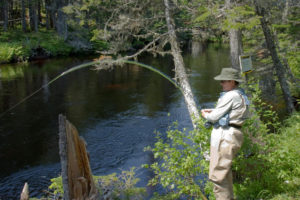
The sun has a huge influence on how fish see the fly floating on the surface. This is why I lecture about the fly’s silhouette instead its shape. Direct sunlight changes the fly’s silhouette quite a bit, and when the sun disappears, the silhouette completely changes again. That’s why changing flies is so important when direct sunlight hits the pool or disappears again. Direct sunlight always increased my numbers, and I personally caught most salmon and grilse during day time as well.
Another tip: when I can see the fish, they can see me also, and I mostly act like as if they can see me ten times better then I can see them. When casting, start with very short line, and don’t make any false casts when it not really necessary. I never do, and even fish out a cast I wasn’t really satisfied with. So if you understand my words well, you’ll start your fly fishing next time without your feet in the water and with gentle short line casts first.
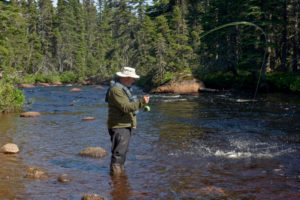
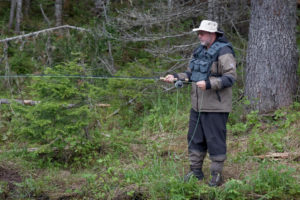
Polarized glasses have lots of benefits, but also a huge disadvantage. You often can see the salmon a lot better when it is rising to take your fly, and that creates a huge problem for many. I never actually face this problem myself because I always set the hook with some delay, exactly as I do with grayling. A big problem in dry fly fishing for salmon is that many people set the hook much too soon, thus removing the fly before the salmon is able take it. Best solution for those people who are striking too fast is to count loudly 21-22 before you set the hook! My delay techniques are not advisable for anybody because I really grow into them by time and experiences. All I can say is that I delay more feelingly and actually using the slack in my line to create my delay. This makes things really hard for people watching me because for outsiders it clearly looks as if I set the hook extremely fast!
When I use dry flies for Atlantic salmon in Norway I succeed most when I present my flies 100% drag free. Exactly the same I do for grayling fishing. With trout I am using many variations in the my presentation and the drag while using dry flies. In Newfoundland it is quite amazing. One day, even at some daily hours I would not recommend any drag at all when using dry flies while in other moments you just need to do exactly the opposite. I am pretty sure with head and tailers that keep coming up over and over again at the same spot. I always present my flies dead drift and totally drag free. The same I do with very small flies. In general, salmon in Atlantic Canada just love skaters, wakers and even water walkers, and they also love wakes around dry flies. It even is a rule for many to create a wake around wet flies and present them on the surface. The Newfie salmon love a wake around the fly! It is probably the wake or fly’s action that attracts them, or makes them more aggressive to take the fly from the surface. If you lose sight of the fly, just let it go. It is not very strange that a salmon or grilse hooking themselves, especially when the fly starts to speed up in the swing and last part of the drift.
I can’t repeat it enough but always keep the number of casts as low as possible. Rivers in Newfoundland are not that deep, fish can rest very close to the bank and false casts really scare them or refuse them to come up. When a fish seems interesting in the fly but doesn’t take it, swap your fly immediately and when you see fish coming up taking your fly very clearly, delay the setting of the hook at least a second. When fish start to play with Bombers by just nosing it or pushing them away, swap the Bomber for deep hanging surface flies, or simply use curved hooks. You will not regret it.
